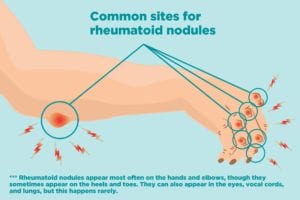

If you have rheumatoid arthritis (RA) and you’ve noticed firm or doughy bumps forming on your joints, you may be one of the approximately 25 percent of RA patients who develop something called rheumatoid nodules. Why rheumatoid nodules occur is largely a mystery, but the good news is that they’re becoming less common.
“I see far fewer patients with rheumatoid nodules than I did 20 years ago,” says Gregory C. Gardner, MD, MACP, a professor in the division of rheumatology at the University of Washington. “That’s due to the new, highly effective medications we now have to treat RA.”
Here, he answers questions RA patients commonly have about rheumatoid nodules.
What Do Rheumatoid Nodules Look Like?
Rheumatoid nodules are usually round and can be as small as a pea or as large as a lemon, according to the American Osteopathic College of Dermatology. “You see rheumatoid nodules most often on the hands and elbows, though they sometimes appear on the heels and toes,” Dr. Gardner says. “It feels like you have pebbles in your shoe.”
Rheumatoid nodules can also appear in the eyes, vocal cords, and lungs, but this happens rarely, he adds. (Read more about how arthritis affects the lungs here.)
Do Rheumatoid Nodules Hurt?
Rheumatoid nodules are typically painless, though they may become painful during an arthritis flare. Depending on their location, rheumatoid nodules can become bothersome; for example, nodules on your heel could make walking difficult. They can also become ulcerated or infected, but that’s not a common occurrence, Dr. Gardner says. (Read more about how arthritis can affect your feet here.)
Why Do Rheumatoid Nodules Occur in the First Place?
Scientists can’t explain that yet, nor do they understand why these nodules aren’t seen in other forms of inflammatory arthritis, like psoriatic arthritis or ankylosing spondylitis. However, it is known that taking methotrexate can sometimes cause methotrexate-induced nodulosis, in which tiny micronodules form rapidly around the joints in your fingers. If that happens, your rheumatologist will likely switch you to a different medication. Here are more common questions patients ask about taking methotrexate.
“The nodules generally disappear when you change drugs,” Dr. Gardner says. “Rituximab is often used in this situation because it’s very effective at getting rid of them.”
Who Is Most Likely to Develop Rheumatoid Nodules?
They’re most commonly seen in people who have more severe RA. “They’re actually a marker of severe disease,” Dr. Gardner says. Smokers also appear to be at greater risk of developing rheumatoid nodules. And a 2016 study found that they occurred significantly more frequently in patients with longstanding disease and those who tested positive for rheumatoid factor and anti-CCP antibodies, as well as in people who take the DMARDs leflunomide and TNF-alpha antagonists.
How Are Rheumatoid Nodules Treated?
Since rheumatoid nodules aren’t painful or dangerous, they don’t need to be treated at all. In fact, sometimes the nodules go away on their own. But if yours are inhibiting your mobility — or if their appearance bothers you — there are ways to shrink them. “Often, we’ll start by switching medications to see if that helps,” Dr. Gardner says. “Injecting the nodules with corticosteroids can also reduce their size.”
Rheumatoid nodules can also be surgically removed, though surgery is generally reserved for people who have infected nodules or ones that limit their ability to use the affected joints. There is a chance the nodules could grow back, though.
Keep Reading
Subscribe to CreakyJoints
Get access to our Rheumatoid Arthritis Patient Guidelines by subscribing to CreakyJoints today.





